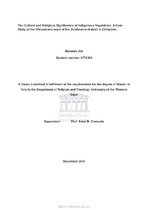| dc.description.abstract | This study is situated in the context of multidisciplinary discourse on the pervasive problem of food insecurity in the southern African context. More specifically, it is situated in the context of the Centre of Excellence in Food Security, located at the University of the Western Cape and its project on “Food Ethics and Values” (with Prof Ernst Conradie as principal investigator). It will contribute to discourse on food security from the perspective of the discipline of religious studies and more specifically African Traditional Religion (ATR) and the indigenous knowledge systems (IKS) associated with that. The consumption of food naturally plays a significant role in African Traditional Religion – as is evident from various taboos on food consumption, rituals with prescriptions on food, calendar-based festivities, but also from daily life in rural villages. In reflecting on food in such rural villages, the focus is often on the consumption of meat (chicken, goats, cattle, but also rodents and other wildlife) and of grains like maize. However, vegetables traditionally also formed part of a family’s daily diet. In pre-colonial times, such vegetables were not necessarily cultivated since some indigenous vegetables were harvested based on indigenous knowledge available amongst village elders and traditional healers. The Chionekano-ward includes some 42 villages with an estimated population of around 1020 persons. Through a process of snowball sampling, semi-structured interviews were conducted with village elders and traditional healers who have knowledge of such indigenous vegetables. Where appropriate interviews were followed up with focus groups discussions in particular villages.
This study investigated the cultural and religious connotations attached to specified indigenous vegetable types in the Chionekano-ward of the Zvishavane-district in Zimbabwe. This study has identified fifteen edible indigenous vegetables. Only eleven indigenous vegetables were among the commonly used. These were classified into three groups. Firstly, there are indigenous vegetables found in the farming lands as weeds. These are Nyovhi/ Spider plant/ Cleome gynandra, Mbuya Mbuya/ Thorny pigweed/ Amaranthus spinosus, Derere/ Wild jute/ Corchorus tridens, Tsine/ Muhlabangubo/ Black jack/ Bidens spinosa, Muchacha/ Wild gherkin/ Cucumis anguria. Secondly there were Indigenous vegetables that use leaves as by-products namely, Muboora/Pumpkin squash/ Cucurbita maxima, Munyemba/ Cowpea leaves/
Vigna unguilata. Thirdly there were commonly used Wild indigenous vegetables found in riverbanks, forests and mountains namely Chirevereve, mubvunzandadya, Fat hen/ Chenopodium album and Nhuri. There were religious and cultural connotations attached to the use of these indigenous vegetables. The study found that there are common shared beliefs on the harvesting, cooking and consumption of these vegetables. These commonly shared beliefs and predominant perceptions on the consumption of indigenous vegetables were mainly shaped by the cultural and traditional religious beliefs systems shared by all the participants. Although the study was of a descriptive nature, it advocated for the preservation of such indigenous knowledge in order to promote avenues towards food security where commercial agriculture may be unable to ensure an equitable distribution of food. | en_US |

